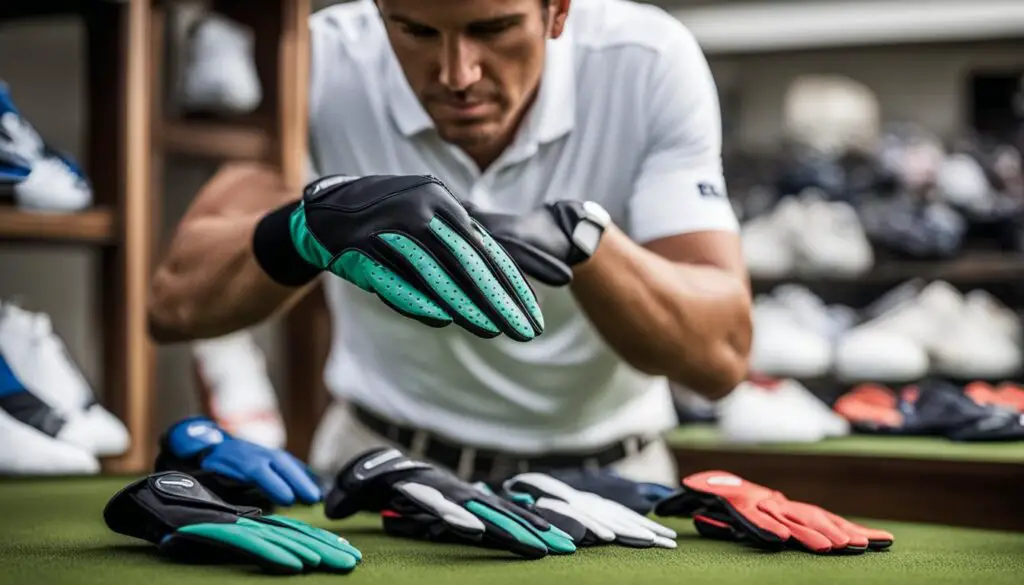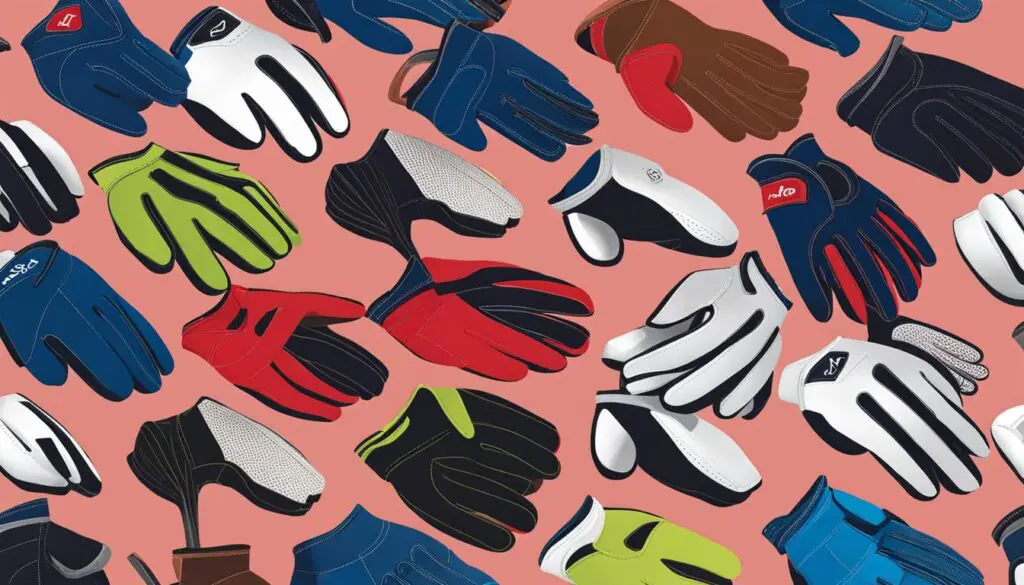Golf gloves are an essential accessory for golfers of all skill levels. They provide improved grip, comfort, and protection for the hands during a round of golf. While some golfers choose not to wear a glove at all, most opt to wear at least one glove during their games. But how many gloves do golfers actually wear?
Traditionally, golfers wear a glove on their weak hand. This means that right-handed golfers wear a glove on their left hand, and left-handed golfers wear a glove on their right hand. However, there are exceptions to this rule. PGA Tour pro Tommy “Two Gloves” Gainey, for example, wears gloves on both hands.
The main purpose of wearing a golf glove is to improve grip and prevent the club from slipping out of the hands during the swing. In addition, golf gloves offer protection for the hands and help prevent blisters and callouses that can result from gripping the club tightly. Choosing the right golf glove is important to ensure optimal performance on the course.
Key Takeaways:
- Golfers typically wear one glove on their weak hand.
- Some professional golfers, like Tommy “Two Gloves” Gainey, wear gloves on both hands.
- Golf gloves enhance grip, comfort, and hand protection during a round of golf.
- Choosing the right golf glove is crucial for optimal performance.
- Golf gloves help prevent blisters and callouses caused by gripping the club tightly.
Types of Golf Gloves
When it comes to golf gloves, there are several different types to choose from. Each type has its own unique characteristics and benefits. Here are the most popular types of golf gloves:
Cabretta Leather Gloves
Cabretta leather gloves are widely regarded as the gold standard in golf glove materials. These gloves are made from the skin of sheep and offer exceptional grip, feel, and breathability. Professional golfers often prefer Cabretta leather gloves due to their superior performance. They provide a soft and natural feel, allowing for better club control and accuracy.
Synthetic Gloves
Synthetic gloves are a more affordable option compared to Cabretta leather gloves. These gloves are made from a combination of fabrics and are coated with a plastic material. While they may not offer the same level of feel and grip as leather gloves, synthetic gloves are known for their durability and resistance to wear and tear. They are a popular choice among golfers looking for a glove that can withstand frequent use.
Hybrid Gloves
Hybrid gloves combine the best of both worlds by featuring Cabretta leather palms and synthetic or other fabric materials on the back of the glove. This combination offers enhanced breathability and flexibility, making hybrid gloves a comfortable option for golfers. They provide a balance between the softness and feel of leather gloves and the durability of synthetic gloves.
Rain Gloves
Playing golf in wet conditions can be challenging, but rain gloves are specifically designed to provide a tacky grip even when the gloves and club are wet. These gloves are made with synthetic materials that offer excellent grip and traction. While rain gloves may not offer the same softness and feel as leather gloves, they are a practical choice for golfers who frequently play in rainy or humid conditions.
The type of golf glove that is right for you will depend on personal preference, budget, and the prevailing playing conditions. Whether you prioritize grip, durability, or breathability, there is a golf glove out there to suit your needs.
Choosing the Right Golf Glove
When it comes to selecting a golf glove, there are several factors that golfers should take into consideration. The right glove can make a significant difference in your game, providing comfort, grip, and durability. Here are some key factors to keep in mind when choosing a golf glove:
Price
Price is an important consideration for many golfers. Golf gloves can vary in price, with premium Cabretta leather gloves usually costing more than synthetic gloves. It’s essential to find a glove that fits within your budget while still meeting your needs for grip and durability.
Breathability
Breathability is another crucial factor, especially if you tend to sweat during your rounds. A breathable golf glove helps keep your hand dry, preventing discomfort and ensuring a secure grip throughout your swing. Look for gloves with breathable materials or strategically placed vents for maximum airflow.
Grip
Grip is perhaps the most critical factor in choosing a golf glove. A secure grip on the club is essential for a confident and effective swing. Leather gloves, such as Cabretta leather, are known for providing excellent grip and feel. Synthetic gloves can also offer a reliable grip, although they may not be as tactile as leather options.
Material and Construction
The material and construction of a golf glove can greatly affect its feel and durability. Cabretta leather gloves often provide a softer, more luxurious feel but may be less durable than synthetic gloves. Synthetic gloves, on the other hand, offer better durability and resistance to wear and tear over time.
Fit
A proper fit is essential for a golf glove to perform at its best. Be sure to consult the size chart provided by the manufacturer to select the correct glove size. A glove that is too loose or too tight can hinder your grip and overall performance on the course.
Durability
When investing in a golf glove, durability is a crucial factor to consider. A durable glove should be able to withstand multiple rounds of play without significant wear and tear. While leather gloves may offer a softer feel, they may not be as durable as their synthetic counterparts.
By considering these factors – price, breathability, grip, material, construction, fit, and durability – you can make an informed decision when choosing a golf glove that suits your needs and enhances your performance on the course.

Frequently Asked Questions about Golf Gloves
As golfers, we often have questions about golf gloves. Below, we answer some of the most common queries to help you gain a better understanding of this essential golf accessory.
Golf Gloves Pros Use
Many professional golfers prefer Cabretta leather gloves from reputable brands. Known for their superior grip, feel, and breathability, these gloves provide the performance and durability that pros rely on.
Cleaning Golf Gloves
Cleaning golf gloves, especially those made from soft leather, can be a bit challenging. To keep your gloves clean and in good condition, follow these simple steps:
- Gently hand wash the gloves in cold water.
- Add a touch of mild detergent and scrub lightly to remove dirt and stains.
- Rinse the gloves thoroughly to remove any soap residue.
- Air dry the gloves naturally, avoiding direct sunlight or heat sources that could damage the leather.
Following this cleaning routine regularly will help prolong the life of your golf gloves and ensure they remain in optimal condition.
Necessity of Golf Gloves
While wearing golf gloves is not mandatory, they offer significant benefits that make them a valuable accessory for most golfers. Golf gloves provide improved grip, enhancing control and consistency in your swings. They also offer protection for your hands, preventing blisters and callouses that can interfere with your game.
Golf Glove Sizes
Choosing the right size for your golf glove is crucial to ensure optimal fit and performance. Each golf glove manufacturer provides a size chart that you should consult to determine the correct glove size for your hand. Properly sized gloves will fit snugly, allowing for a comfortable grip without any excess material that could affect your control.
By understanding these frequently asked questions about golf gloves, you can make informed decisions when it comes to purchasing, cleaning, and sizing your gloves.

Conclusion
Golf gloves are an essential part of any golfer’s gear. Not only do they provide an improved grip on the club, but they also offer comfort and protection for your hands. When choosing the right golf glove, it’s important to consider factors such as price, breathability, grip, material, construction, fit, and durability. Striking the right balance between these factors will enhance your performance on the course.
Whether you prefer Cabretta leather for its excellent grip and feel, synthetic gloves for their affordability and durability, hybrid gloves for enhanced breathability and flexibility, or rain gloves for a tacky grip in wet conditions, selecting a glove that fits well and provides the desired level of grip and feel is key to a more enjoyable and successful golfing experience.
Don’t underestimate the importance of golf gloves when it comes to your golf gear essentials. They play a significant role in your game and can make a difference in your swing and overall performance. So, make sure to choose the right glove for you and elevate your golfing experience to new heights.
FAQ
What types of golf gloves are available?
There are several types of golf gloves to choose from, including Cabretta leather, synthetic, hybrid, and rain gloves.
How many gloves do golfers wear?
Most golfers wear at least one glove on their weak hand, either left or right, depending on their dominant hand. Some players, like Tommy “Two Gloves” Gainey, wear gloves on both hands.
What are the benefits of wearing golf gloves?
Golf gloves improve grip, prevent slipping during the swing, offer hand protection, and help prevent blisters and callouses.
What is the difference between Cabretta leather gloves and synthetic gloves?
Cabretta leather gloves offer excellent grip, feel, and breathability, while synthetic gloves are more affordable and durable but may lack the same level of feel and grip.
How do you clean golf gloves?
Cleaning golf gloves can be challenging, especially if they are made from soft leather. It is recommended to hand wash gloves in cold water with mild detergent, rinse thoroughly, and let them air dry naturally.
Are golf gloves necessary for playing golf?
While not mandatory, golf gloves are beneficial for most golfers as they improve grip and offer hand protection.
What size golf glove do I need?
Proper sizing is crucial for optimal fit and performance. Each manufacturer provides a size chart that should be consulted to determine the correct glove size.
